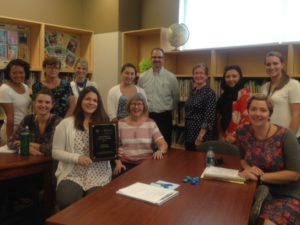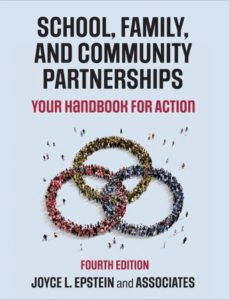Kennewick, Washington

Row 1 (L to R): Tracey Casey, Nicole Dunn, Pam Henager, Amanda Haan (ATP Co-Chair)
Row 2 (L to R): Anne Rogers, Debbie Clayton, Becky Gant, Annabelle Gonzalez, Dale Kern (Principal), Kathy Dechter, Nesreen Al Muzayen, Kori Cannon (ATP Co-Chair)
Culture Night
Culture Night was organized to celebrate the diversity of students and families at the school, and make everyone feel welcome. Many families who immigrated from other counties were overwhelmed by the American school system. Culture Night aimed to welcome all families, encourage engagement, and help everyone learn about cultures that were new to them.
An initial challenge was to make sure the celebration was not stereotypical or insensitive and allowed everyone’s culture to be represented comfortably. The plans were simplified to focus on food, music, art, and geography. Classroom projects broadened the scope of the event. During a potluck dinner with food dishes from all home countries, music from various cultures was shared. After dinner, families walked through the school to enjoy the grade-level cultural projects:
- Kindergarteners colored flags representing their home countries
- 1st graders made paper mache globes marking their home countries
- 2nd graders made art projects celebrating their native dress
- 3rd graders illustrated folk tales from their home countries
- 4th graders completed a research project and created posters with information on their home countries
- 5th graders read, translated, and illustrated poems from their home country
As families toured the projects they placed a pin on a large map marking their home country.
Home Visits
The English Second Language teacher and kindergarten team conducted home visits to get to know the families of their students. Visits were planned around the family’s home language. Teachers traveled in groups of two and talked with parents for about 15-20 minutes. Most visits were conducted during Wednesday team-planning days, but there were a few evening visits.
The teachers noted several benefits from the visits. In the classroom, teachers drew information that was learned by talking with parents and students, and by seeing the home. For example, one student had a garden so the teacher used that information during a unit on pumpkins. Many students improved behavior and schoolwork after the visits. Families were pleased that teachers took the time to visit them at home. More volunteered to help the school, more called the school to explain when children were ill, and more were comfortable about coming to the school. The home visits built a sense of mutual respect and trust among all partners in children’s education.

